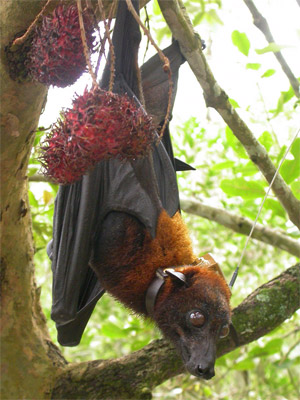World's largest bat hunted nearly to extinction
Under the current legal hunting rate scientists predict that the world’s largest bat, the aptly-named large flying fox or Pteropus vampyrus, faces extinction in six to 81 years. Increasing the urgency to save the large flying fox is the vital role it plays as an ecosystem engineer (a species whose behavior can shape an ecosystem); the species maintains Southeast Asian forests by dispersing a wide variety of seeds over distances farther than most birds and other mammals. To discover if current hunting is sustainable, Dr. Johnathan Epstein, a veterinary epidemiologist with the Wildlife Trust, and his team surveyed bat populations on Peninsular Malaysia from 2003 and 2007 and compared their findings with the number of hunting licenses issued by the Malaysian Department of Wildlife and National Parks. Their results published in the Journal of Applied Ecology found that currently 22,000 bats are hunted legally in Malaysia every year, an amount the scientists said was wholly unsustainable even under the researcher’s most optimistic population estimate of half a million individuals worldwide. Using computer modeling, the scientists predicted that if current hunting practices are not changed the bat would go extinct in six to 81 years. They hasten to add that this projection doesn’t even take into account the number of bats that are hunted illegally and the amount killed as pests by farmers every year. …
World’s largest bat threatened with extinction due to legal hunting
